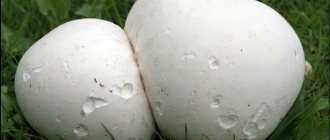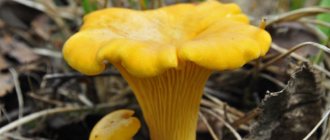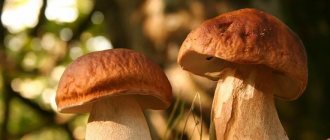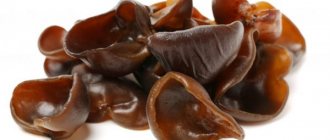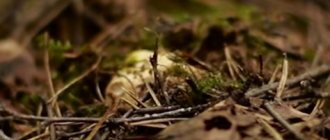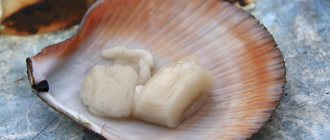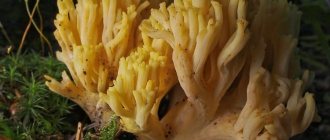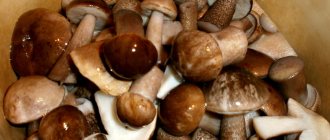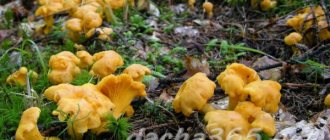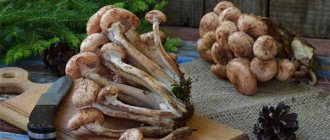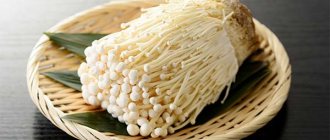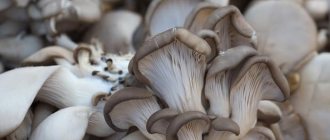Description of the mushroom
The black chanterelle fully corresponds to its name: the fruiting body is black or black-gray, the shape resembles a tube.
The diameter of the cap is from 3 to 8 cm, the edges are wavy, the surface is black, becoming brownish in dry weather.
The pulp is also black, with a gray tint, aromatic and pleasant to the taste. The stem is hollow, rigid, narrowed at the base, about 1 cm in diameter, height from 5 to 12 cm, together with the underside of the cap, covered with a waxy coating.
Fungi most often grow in colonies.
Similar species
The funnel beetle is easily identified due to its cup-shaped shape, dark coloration and tendency to grow in crowded groups. Related species: Craterellus sinuosus
) (Fr.) Fr. differs from the funnel-shaped funnel in a lighter, yellowish color and a more dissected cap. Unlike species of the chanterelle genus (for example, the gray chanterelle), the funnel funnel-shaped funnel does not have pseudoplates on the lower surface of the cap.
Also bears some resemblance to Urnula craterium
) (Schwein.) Fr., a dense, leathery, goblet-shaped mushroom of almost black color. In contrast, the funnel is horn-shaped and has the shape of a bowl with a turned-down edge.
Where do they grow and when to collect?
The most productive places: Karelia, Kaliningrad, Pskov and Tver regions, Altai, Southern Urals and Siberia. Collected from mid-June to the end of October. Despite such a long time period that allows you to bring home these gifts of the forest, nevertheless, according to experienced lovers of “silent hunting,” August-September are considered the months when you can collect the richest “catch” of these incredible mushrooms.
The black chanterelle grows not only where the yellow one is usually found. She prefers to settle on clay and calcareous soil in moist deciduous and mixed forests, in open sunny areas with a lot of fallen leaves.
Mushrooms grow in large families
It forms mycorrhiza with spruce and broad-leaved species: oaks, lindens and hazel.
It is also often found on the sides of paths and ditches, in mountainous areas.
Due to their black color, it is difficult to notice the mushrooms, but not far from one specimen you can find a whole clearing, because they grow in large colonies.
In order not to spend a long time looking for funnel mushrooms next year, you should use this technique: soak the caps of several mushrooms for 24 hours, break them into small pieces and scatter them in a promising place. The crops need to be watered with the resulting infusion.
Growing
It is possible to grow gray chanterelles on your own in your garden plot, in a park or in the forest. They do not require special care, but the main difficulty is proper planting of the mycelium.
It is important to know that the funnel is attached to the root system of the tree, so the place for the future harvest should be chosen near any forest plant.
This is a very important point: mushrooms will not grow next to a garden tree. To the selected “donor” you can add both ready-made mycelium, carefully dug out in the forest, and spores.
Or dig up a young tree there with mycelium already rooted on it and plant it in the country. In this case, it is important to take two more bags of forest topsoil, which will need to be used to fertilize the planting site.
REFERENCE Cultivated chanterelles should be watered moderately, constantly keeping the soil moist and not allowing it to dry out, simulating the natural habitat of mushrooms.
How to cook properly
Only the tubular funnel of the fruiting body is eaten; the rough base of the stem is removed. The easiest way to do this is on the spot - in the forest, so as not to carry home something that will be thrown away anyway.
Black chanterelle is used in fried and stewed dishes, soups, sauces and seasonings. It goes well with mushroom pastas in creamy sauce and risotto. It also goes well with wine when preparing sauces for meat.
In European countries, this specimen is highly valued and is considered a delicacy, and the French even call it a “truffle on a leg.”
You need to cook for 20-30 minutes, during which time the fruit acquires a more saturated black color.
Irina Selyutina (Biologist):
When boiled, some of the pigments from the fruiting body of the black chanterelle are released into the water and the broth acquires a color reminiscent of oil. Therefore, people who encounter these mushrooms for the first time should not panic. The broth should be drained, the mushrooms should be washed (optional) and fried as usual.
To prepare the soup, you can take either mushroom powder from black chanterelles or dried halves. They need to be soaked for 2 hours in cold water and then cut into pieces.
And when dried, the mushroom aroma intensifies, so the mushroom is dried for future use. It is better to do this in an electric dryer at a temperature of 40-50 °C.
The mushrooms are first broken or cut lengthwise into two parts. This makes it easier to remove debris and snails from the tube, which really like to get in there. This simple operation will allow the drying process to go faster.
Use in medicine
The mushroom has immunostimulating, bactericidal and antiparasitic properties. But before use, you should consult your doctor.
If you intend to prepare a preparation based on chanterelles at home yourself, then you must contact a specialist for recommendations.
Due to the content of a special substance - chitinmannose, which is poisonous to parasites, the black fox is not worm-eaten.
Also, thanks to research by Western scientists, it was revealed that the polysaccharides contained in the mycelium are endowed with antitumor abilities.
Black chanterelles are tasty and quite rare mushrooms. They contain many useful components, which is why many lovers of quiet hunting are so eager to harvest a whole harvest.
Edibility, beneficial properties and contraindications for use
Black mushroom belongs to category 4 of the edible group. Its fruits do not require pre-processing. For gastronomic purposes, only the caps (the funnel-shaped part of the mushroom) are used. The flesh of the legs is very tough and difficult to chew.
Interesting!
Mushrooms have beneficial properties. Their fruits are used in folk and traditional medicine for the preparation of medicines in the form of alcohol tinctures, oily extracts, and powder.
The black variety of chanterelles has the following properties:
- bactericidal;
- anthelmintic;
- anti-inflammatory;
- immunostimulating.
Mushrooms promote the production of hemoglobin in the blood. They are also used in complex therapy aimed at restoring the visual organs.
There are no special contraindications to the use of funnel mushrooms. The existing range does not go beyond the standard restrictions on eating mushrooms - pregnancy and lactation, diseases of the gastrointestinal tract, children under 5 years of age.
Culinary features of the black chanterelle - Website of M. Vishnevsky “FOR MUSHROOMS”
As you know, in Europe the black chanterelle is very popular and quite expensive. Sometimes it is even called a “truffle on a leg.” This is due not only to its high taste, but also to the ever-growing movement for eating clean, unprocessed natural foods. Indeed, like its yellow relative, the black chanterelle is not worm-eaten, you don’t need to peel it or carry out any other actions, just wash it and go. Meanwhile, we must not forget about the taste of black chanterelle. It is very strong (as is the aroma), is not lost during cooking or drying, like yellow chanterelle, and the dried mushroom lasts longer than all other types.
False and poisonous doubles of the Trumpet fungus horniform
Most often, the funnel-shaped funnel is confused with the gray chanterelle. Sometimes both are called Black Chanterelle, although this species does not exist. Crows and chanterelles are relatives, although quite distant: they belong to the same family, but different genera. It is very simple to distinguish them: the gray Chanterelle has pseudoplates, while the funnel-shaped funnel-shaped one does not have any folds, it has wrinkles.
Gray chanterelle
However, both of them are edible, so even if they are confused, nothing unpleasant will happen. Gray chanterelle is considered by some to be tasteless and for this reason is classified as a conditionally edible mushroom, but the same is said about the common chanterelle.
There is an opinion that the goblet funnel is similar to the sinuous funnel. But the second one is much smaller (3–5 cm in both height and diameter) and a completely different color. Sinuous funnelworts can also be of a darker color, but in this case they have a light rim along the edges of the cap, which you will never see in a horned one. The tortuous funnelweed is classified as inedible due to its tastelessness.
Sinuous funnelwort
Somewhat similar to the funnel-shaped funnel-shaped Urnula goblet. It is inedible due to its unpleasant taste. Unlike urnula, the flesh of the horn-shaped mushroom is brittle, and the edges of the cap are turned away. It looks more like a chanterelle, and the goblet-shaped urnula cap resembles a cognac glass.
Urnula glass-shaped
Until recently, the funnel-shaped funnelwort Craterellus cornucopioides and its North American counterpart Craterellus fallax were considered different species and even found differences in their gastronomic quality. However, geneticists have put an end to the chefs' dispute, and now there is no need to describe the completely insignificant difference between these forms, which turned out to be genetically identical at the species level.
Black chanterelle (horn-shaped funnel): description and distribution
The funnel fungus (black chanterelle), a little-known edible mushroom, is described. The places of its distribution, the fruiting season, similar species and the culinary uses of the carob-shaped funnel mushroom are indicated. Little-known edible mushrooms, as a rule, do not inspire much confidence at first glance, so only well-informed mushroom pickers dare to collect them. Some of these species - such as the black-gray funnel-shaped funnel (black foxtail) - due to their discreet coloring, can be difficult to detect. However, an experienced collector who has learned to look for these dark “horns” very quickly fills the basket with them.
Description
The edible funnelweed (Craterellus cornucopioides) is a member of the chanterelle family. Known by other names - black horn, funnel-shaped funnelwort, horn-shaped craterellus, gray funnelwort, black chanterelle.
This mushroom is characterized by the following characteristics:
- fruiting body up to 10 cm high;
- the cap with rolled edges has the shape of a very deep funnel with a diameter of 3 to 5 cm. The inside is grayish-black, with a brown tint in young fruiting bodies. The outer side is grayish-white, tuberous, and wrinkled; as the spore matures it becomes powdery, grey-gray;
- This species does not have pseudoplates or similar longitudinally folded structures;
- light spores;
- a very short leg up to 0.8 cm thick, the color of the cap, narrowed towards the base;
- the pulp is grayish, tender, thin, has a weak mushroom taste and aroma, which intensifies when dried.
Distribution and fruiting season
The funnel-shaped funnel grows in North American and Eurasian forests, lowland and mountain. Prefers a mixed and deciduous composition of tree species, inhabits open, sufficiently lit places with well-moistened clay, calcareous soil. It readily settles on the fallen leaves of oaks and beeches, forming large clusters. Fruiting bodies begin to grow in June and are found in warm autumn until November, but maximum yields are typical for August-September.
Similar species
According to the description, the horned funnel is most similar to the related gray fox, otherwise the gray funnel (Cantharellus cinereus), similar in color and tendency to grow in large groups. The main difference is the pseudoplates, which are absent in the funnel funnel, but are present in the edible gray chanterelle.
The black chanterelle differs from the inedible brownish-black goblet (Urnula craterium) by the edges of its cap, which are distinctly curled outward.
Edibility
In our country, the funnel mushroom is classified as an edible mushroom of the 4th taste category, but in Western European countries it is considered a delicacy. For mushroom cooking, only the “funnels” themselves are used without rigid base legs. They are cleared of forest debris and either sent to dry or washed and then used in stir-fries, soups, sauces and stews. Dried “horns” become brittle, are easily ground into powder and are used as a seasoning and flavoring agent for delicious sauces.
Black chanterelles are edible mushrooms with a special shape and dark color, hardly noticeable among the fallen forest foliage. However, during the mushroom season, real experts will definitely collect them in quantities sufficient for culinary use and aromatic preparation in dried form.
Assessment of taste qualities, benefits and possible harm
Funnel mushroom has a distinct mushroom flavor that will enhance any dish or sauce. Gourmets claim that it has a bright mushroom taste with notes of smoke and a fruity aroma.
All mushrooms of the Chanterelle family are rich in potassium, calcium and phosphorus. They contain relatively little protein (only 28.3%), but there are enough vitamins B, A, D and polyunsaturated fatty acids.
The funnel-shaped funnelwort, collected in clean places, does not cause any harm. Like any mushrooms, it is contraindicated for people with sensitive digestion.
Medicinal properties and use in folk medicine
It is believed that the funnel fungus has bactericidal properties and also stimulates the immune system. Previously, it was applied raw or in powder form to wounds and abscesses.
It was also used as an anthelmintic: the fact is that funnelwort contains the substance chitinmannose, which is poisonous to parasites. It is thanks to her that tube mushrooms, like chanterelles, are not wormy.
Now in the West, the antimutagenic properties of funnelwort and its antitumor effect are being actively studied. The first results have already been obtained, the work of scientists continues.
Gray chanterelle / Edible mushrooms, berries, herbs
The gray chanterelle in mushroom encyclopedias can also be referred to as funnelwort or funnelhead craterellus. It grows in rather large groups and bunches from August to October in deciduous-coniferous forests. For an inexperienced mushroom picker, a mushroom evokes only one feeling: kick this mushroom, and go look further for only normal mushrooms. The appearance, of course, is still the same: unsightly, similar to the output part of a musical trumpet, black in color, growing in clusters the way toadstools usually like to grow. An experienced mushroom picker knows that it surpasses even the real yellow chanterelle in taste and aroma. And to compete with the yellow chanterelle - a mushroom classified in the first category - you still have to try.
The funnel-shaped cap of brown-black or gray-black color has a diameter of 3 to 8 cm. In adult mushrooms, the cap is covered with a characteristic whitish coating (spores) and appears powdery. The leg is hollow inside, narrowed downward, up to 12 centimeters in length. The flesh of the mushroom is gray-black or black in color, very fragile. The color of the pulp does not change even when gray chanterelles are dried. The pulp of the mushroom has a pleasant smell.
Photos of black chanterelle mushroom
Description of the gray chanterelle in literary sources
Recipes for mushroom dishes from gray chanterelles
A very tasty culinary mushroom. Mushroom soups and sauces are especially tasty. Very often, gray chanterelles are dried and mushroom powder is made from dried chanterelles. The aromatic mushroom powder is used in various dressings, sauces and other dishes.
Bruschetta with wild mushrooms
Sandwiches with chanterelle mushrooms
Mushroom puree soup with croutons
There are even more recipes for cooking dishes with chanterelles in the “Recipes with Mushrooms” section of the site.
The fox is real
Autumn honey mushrooms
Preparations with mushrooms for the winter
False doubles
Black chanterelles are perhaps one of the most prominent representatives of the mushroom kingdom. It is easy to distinguish from related species due to its dark color, cup-shaped shape and the fact that specimens grow in groups. It is quite difficult to confuse this species with others, but it is still worth knowing some possible “doubles”.
A related species of the funnel funnel is the sinuous funnel, which has a lighter yellowish color and a dissected cap. This species is somewhat similar to Urnula goblet. This is a leathery, dense, goblet-shaped mushroom, black in color. In contrast to this species, the black chanterelle is more fragile and looks like a bowl with raised edges.
Sinuous funnel
Features of cooking black chanterelles
In Russia, black chanterelles live in the European part, Siberia, the Caucasus and the Far East. They prefer moist forests, open areas along roads and paths.
The funnel is considered a delicacy. The upper part, the cap in the form of a deep funnel, should be cooked and eaten. It is fibrous to the touch, brown in color, and in adult mushrooms it becomes dark gray. The leg is short, hollow, up to 1 cm thick.
Rules for working with the product:
- after collection, the funnel-shaped part is cut off and the stem is thrown away;
- the resulting product is cleared of forest debris;
- large specimens are cut into pieces, then immersed in clean water for 30 minutes;
- Before preparing dishes, the mass is washed several times with running water.
The pulp of fresh specimens is thin, easily broken, it has practically no smell or taste, but appears during drying and cooking.
How to cook black chanterelles
Black chanterelles are subjected to different types of culinary processing. Cooking them is very simple; it does not require special skills or equipment. The simplest options are to fry or boil them. These mushrooms go well with other foods: carrots, potatoes, onions, chicken, meat.
How to fry black chanterelles
Fried black chanterelles are an excellent side dish for hot dishes. To prepare it, you will need vegetable oil or butter. You can also use any suitable frying pan.
You need to prepare the dish in the following order:
- The cleaned and washed product is cut into small pieces.
- Place oil in a frying pan and turn on the heat.
- When the oil is hot, place the mushroom mass into the container.
- Cover the pan with a lid and fry the mushrooms over medium heat. The mass is stirred periodically.
- After 15 minutes the stove is turned off.
How to dry black chanterelles
In European countries, funnelweed is consumed in dried form. This product takes up little space and can be stored indoors or in the refrigerator without any problems.
Chanterelles are dried in one of two ways: whole or ground to obtain a powder. The pulp of mushrooms is very brittle and is easily processed into a homogeneous mass.
Mushrooms are dried in the open air or using household appliances. In the first case, choose a sunny, ventilated place. First, the caps are cut in half or into smaller pieces. Then they are distributed in one layer on a newspaper or baking sheet.
It is more convenient to use household appliances to dry black chanterelles. An oven or a regular dryer will do. The product is distributed on a baking sheet and placed inside. The device is turned on at a temperature of 55 – 70 °C. It is recommended to cook mushrooms for 2 hours.
Black chanterelle recipes
Recipes for the fungus fungus carotid are very diverse. It is combined with meat, chicken and vegetables. Dishes with chicken, cheese and meat deserve special attention.
How to cook black chanterelle mushrooms with onions and chicken
Chicken combined with funnel mushroom is a dietary dish. It is recommended to cook it with onions, which will only improve the final taste.
- chicken fillet – 250 g;
- mushrooms – 400 g;
- onion - 1 pc.;
- frying oil;
- salt and pepper - optional;
- dill or other greens.
Prepare a dish of chicken and funnelfish according to the recipe:
- The caps are washed and cut into pieces.
- The onion is cut into rings and mixed with chanterelles.
- The mass is fried in butter or vegetable oil.
- Add salt and pepper to the fillet, then fry each side for 2 minutes. Wait until a crust appears on the surface.
- Place the fried chicken in a deep frying pan. The mushroom mass is placed on top.
- Cover the container with a lid and keep on low heat for 5 minutes.
- The finished dish is laid out on plates. If desired, sprinkle greens on top.
How to cook black chanterelles with cheese
Dishes made from black chanterelles with the addition of cheese are very tasty. It is better to cook the dish in a frying pan with high walls.
- fresh chanterelles – 700 g;
- hard cheese – 200 g;
- onion – 2 pcs.;
- garlic – 2 cloves;
- vegetable oil – 3 tbsp. l.;
- salt and pepper.
You need to cook chanterelles with cheese according to the following sequence:
- Mushrooms are washed and cut into large pieces.
- Pour oil into a frying pan, add onion, cut into rings.
- The onion is fried until it turns golden.
- Place a funnel in a frying pan, add salt and pepper.
- Fry the mass with the lid closed until the liquid evaporates.
- The hot dish is sprinkled with grated cheese and garlic.
- Cover the container with a lid and keep on moderate heat for 3 minutes.
Meatloaf with black chanterelles
Funnelfish goes well with meat and fish. It makes a delicious meatloaf, to which potatoes, semolina, onions and spices are also added.
Before preparing the roll, you need to check that all the ingredients are present:
- minced meat – 1.2 kg;
- chanterelles – 300 g;
- potatoes – 2 pcs.;
- semolina – 100 g;
- chicken egg – 1 pc.;
- clean water – 150 ml;
- onion – 1 pc.;
- boiled rice – 300 g;
- pepper and salt - to taste.
How to prepare black chanterelle meatloaf:
- The potatoes are grated on a fine grater.
- Semolina, potatoes, water, eggs, salt and pepper are added to the minced meat. The mass is left for several hours.
- Fry the onion and mushroom mass in a frying pan, add salt and pepper.
- Place minced meat on foil. Rice and mushrooms are placed on top.
- The foil is rolled up to form a roll.
- The workpiece is placed on a baking sheet and baked in the oven for 45 minutes.
Black chanterelle sauce
Funnel mushroom sauce goes well with meat and fish dishes, cereals and vegetables. As a result, the food acquires a spicy mushroom taste and aroma.
Ingredients for black chanterelle sauce:
- funnel – 500 g;
- bulbs – 2 pcs.;
- sour cream – 200 g;
- cheese – 100 g.
Prepare the sauce according to the recipe:
- Grind onions and mushrooms in a blender.
- Fry the onion in a frying pan until it turns yellowish.
- Then chanterelles, sour cream and grated cheese are added to it.
- Cover the container with a lid and keep for 10 minutes over moderate heat.
Black chanterelle soup
You can make soup from powder or whole parts. If fresh specimens are used, they are first thoroughly washed with running water.
Ingredients for mushroom soup:
- funnel – 500 g;
- potato tubers – 400 g;
- onion – 150 g;
- butter – 50 g;
- sunflower oil – 50 ml;
- sour cream – 150 ml;
- clean water – 2 l;
- onions or other greens - to taste;
- salt, ground black pepper.
Recipe for funnelwort soup:
- Mushrooms are poured into a saucepan and filled with water.
- The liquid is brought to a boil, the foam is removed regularly.
- Potatoes are cut in a convenient way and placed in a container. The mass is boiled for 15 minutes.
- Melt butter in a frying pan. Then add sunflower to it.
- The onion is cut into rings and fried in a frying pan. Then it is poured into the pan.
- Cook the soup for another 7 minutes.
- Add sour cream and chopped herbs to the pan, salt and pepper to taste.
- Wait for the soup to boil and turn off the heat.
Harvesting black chanterelles for the winter
Black chanterelles are convenient to store dried or frozen. Canned funnel mushroom retains its good taste. In winter it is used as a snack. The easiest way is salting. Such preparations are stored for no more than a year.
Ingredients for winter preparations:
- fresh mushrooms – 1 kg;
- salt – 40 g;
- water – 1 l;
- garlic cloves – 2 pcs.;
- black or allspice – 10 peas;
- cloves – 3 pcs.;
- bay leaf – 4 pcs.
To prepare a funnel for the winter follow the recipe:
- The mushrooms are cleaned and placed in cold water along with salt and spices. They are cooked for 30 minutes after boiling.
- Garlic cloves are cut into thin slices.
- Garlic and mushroom mass is placed in a pickling container. Then the hot brine is poured out. A load is placed on top.
- After a day, the oppression is removed.
- The product is placed in sterilized jars and sealed with lids.
